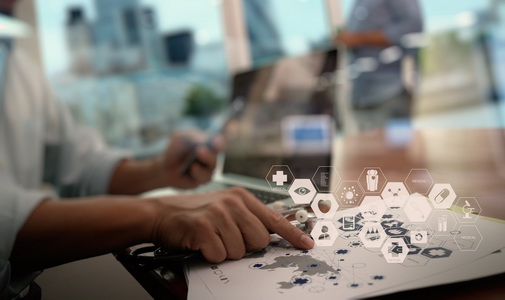Author: Suwan Juntiwasarakij, Ph.D., Senior Editor
เทคโนโลยีกำลังเปลี่ยนความสัมพันธ์ระหว่างคนไข้ ผู้บริการการแพทย์ และระบบการดูและสุขภาพ การนำเทคโนโลยีขั้นสูงที่มีรากฐานที่เชื่อมต่อโครงข่ายและรองรับปฏิสัมพันธ์ที่จะเกิดขึ้นนี้มีความสำคัญต่อเศรษฐกิจของทุกประเทศ เทคโนโลยีสื่อสารเคลื่อนที่ที่กลายเป็นอุปกรณ์คู่กายของทุกคนมีบทบาทสำคัญมากในการเชื่อต่อคนไข้เข้ากับผู้บริการการแพทย์ ผลก็คือการรักษาได้ผลดีขึ้นเพราะข้อมูลคนไข้ได้ถูกเก็บอย่างต่อเนื่องตลอดเวลาแบบเรียลไทม์ และด้วยข้อมูลนี้เองทำให้ผู้บริการทางการแพทย์สามารถลงมือรักษาแก้ไขเหตุการณ์ได้อย่างทันท่วงทีเมื่อจำเป็น ป้องกันความเจ็บป่วยก่อนที่จะเกิดขึ้นและเพิ่มคุณภาพชีวิต โดยเฉพาะอย่างยิ่งในยามที่ประชากรทั่วโลกกำลังก้าวเข้าสู่ความชราเกิดภาวะพึ่งพาอย่างเสียไม่ได้ บทความนี้ได้นำเสนอสามปัจจัยขับเคลื่อนกระบวนทัศน์ใหม่ของอุตสาหกรรมทางการแพทย์และสุขภาพได้แก่ ภาวะพึ่งพิงของประชากร เทคโนโลยี Internet-of-Things (IoT) และปัญญาประดิษฐ์

AGING THAT PULLS
ภาวะประชากรชราภาพและการขยายตัวของกลุ่มชนชั้นกลางพลักดันให้เกิดการแพทย์แบบมีส่วนร่วม ข้อมูลสหประชาชาติพบว่าภายในปี 2050 นี้ 1 ใน 5 ประชากรจะมีอายุมากกว่า 60 ปี ด้วยอัตราเร็วนี้ส่งผลต่อการเติบโตของอุปสงค์การบริการสาธารณสุขและค่าใช้จ่ายที่เพิ่มขึ้น ในบางภูมิภาคจะมีผู้สูงอายุมากกว่า 60 ปีถึง 25 เปอร์เซ็นต์ภายในปี 2030 และไม่ว่าจะด้วยภาวะเศรษฐกิจ ประชากรชราภาพ หรือโรคระบาดเรื้องรัง ต่างก็ส่งผลคล้ายคลึงกันคือต้นทุนของการให้บริการที่สูงขึ้นแบบก้าวกระโดด ตัวอุตสาหกรรมเองต้องปรับตัวภายใต้แรงกดดันด้านต้นทุนซึ่งส่งผลกระทบต่อประสิทธิภาพและคุณภาพในที่สุด คาดว่าเทคโนโลยีดิจิทับจะเป็นความหวังทางออกของปัญหาดังกล่าว และไม่เพียงแต่คนไข้เท่านั้น ผู้บริการทางการแพทย์ก็ได้รับประโยชน์จากเทคโนโลยีนี้ไม่ยิ่งหย่อนไปกว่ากัน

DIGITIZING SUPPORTS WITH THE IoT WEARABLES
การนำเทคโนโลยี IoT มาใช้ในอุตสาหกรรมการแพทย์จะเป็นการเปิดประตูไปสู่ดินแดนใหม่แห่งการรักษาวินิจฉัยด้วยความถูกต้องแม่นยำด้วยอุปกรณ์เซ็นเซอร์ที่มีความฉลาดและยังมีขนาดเล็ก อุปกรณ์แบบสวมใส่ที่ติดตามเราไปทุกที่จะเก็บข้อมูลจากตัวผู้สวมใส่เพื่อประมวลผลทางการแพทย์ เช่นนี้เอง ทำให้กลุ่มอุตสาหกรรมทางการแพทย์มีประสิทธิภาพมากขึ้น การตรวจระยะไกลนี้เองช่วยให้ลดภาวะเสี่ยงต่อการเจ็บป่วยแบบเฉียบพลัน ลดภาระโรงพยาบาล อีกทั้งระบบสื่อสารแบบสองทางช่วยให้คนผู้ป่วยและแพทย์สื่อสารได้ง่ายขึ้น การแพทย์อัจฉริยะแบบมีส่วนร่วมจึงเกิดขึ้นได้

(Source: The Rise of Consumer Health Wearables: Promises and Barriers)
เป็นที่นับจับตาว่าตลาดโลกในกลุ่ม IoT ทางการแพทย์จะเติบโตเป็นประวัติกาล ซึ่งมีมูลค่าถึง 60.4 พันล้านเหรียญในปี 2014 และคาดว่าจะทะยานขึ้นเป็น 136.8 พันล้านเหรียญในปี 2021 โดยเฉพาะตลาดอุปกรณ์ส่วมใส่ที่จะมีมูลค่าถึง 34 พันล้านเหรียญ จากยอดขาย 411 ล้านชิ้น ภายในปี 2020 ในยอดนี้ จะเป็นตัวนาฬิกา Smart Watch และ สายรัดข้อมือออกกำลังเพื่อสุขภาพเมื่อรวมกันถึง 50% เมื่อมีการสร้างระบบวินิจฉัยทางไกลเพื่อติดตามคนไข้กลุ่มโรคเบาหวานและหอบหืดด้วยอุปกรณ์สวมใส จะส่งผลทำให้ผู้เล่นในอุตสาหกรรมนี้เกิดความต้องการระบบนี้มากขึ้นไปด้วย เช่นที่พบว่ามีผู้ป่วยลงทะเบียนเข้าร่วมโครงการวินิจฉัยทางไกลด้วยอุปกรณ์สวมใส่เป็นจำนวนถึง 7.1 ราย โดยข้อมูลทางการแพทย์นี้ส่งผ่านอุปกรณ์สื่อสารของตัวผู้ลงทะเบียนเอง
การสร้างระบบทางการแพทย์และสุขภาพด้วยรากฐานของเทคโนโลยี IoT นี้ได้เปลี่ยนรูปแบบแผนการประกรอบธุรกิจในอุตสาหกรรมนี้โดยสิ้นเชิง ทุกฝ่ายต่างได้รับประโยชน์ ไม่ว่าจะเป็นลดต้นทุน เพิ่มประสิทธิภาพในการรักษา เพิ่มขีดความสามารถในการบริหารจัดการโรคภัย ทำให้ประสบการณ์ในการรับบริการในฐานผู้ป่วยดีขึ้น สามารถเฝ้าระวังโรคเรื้องรังได้ง่ายขึ้น และการจ่ายยาก็ดีขึ้นด้วย
ARTIFICIAL INTELLIGENCE THAT CURES
วิทยาการอันล้ำหน้าด้านเทคโนโลยีดิจิตอลคอมพิวเตอร์สาขาปัญญาประดิษฐ์ผนวกเข้ากับข้อมูลที่มีอยู่อย่างล้นหลามในโลกมีผลดีคือลดความผิดพลาดและยังทำให้การเข้าถึงบริการทางการแพทย์เป็นไปได้โดยง่าย อย่างไรก็ดีตัวปัญญาประดิษฐ์จะไม่มีวันที่จะทดแทนบุคลากรทางการแพทย์ได้ในเวลาอันใกล้ หากแต่เป็นเครื่องมือสนับสนุนเพื่อแรงกดดันในการทำงานของบุคลากร ปัญญาประดิษฐ์ทางการแพทย์นี้ประกอบไปด้วยหลายองค์ประกอบทางเทคโนโลยีที่มีความสามารถตั้งแต่ตรวจจับสภาวะสิ่งแวดล้อม ทำความเข้าใจ ตอบโต้ และเรียนรู้ ซึ่งต่างจากเทคโนโลยีรุ่นก่อนๆ นับว่าได้ว่าปัญญาประดิษฐ์เพื่องานการแพทย์มีความสามารถที่จะส่งเสริมสมรรถนะของบุคลากรทางการแพทย์ได้อย่างแท้จริงนับตั้งแต่อ่านฟิล์มเอ็กซ์เรย์ไปจนถึงวินิจฉัยโรคเลยก็ว่าได้

(Source: Tractica’s “Artificial Intelligence for Healthcare Applications” report)
ปัญญาประดิษฐ์นี้ตอบสนองต่อเป้าหมายขององค์สมัยในยุคสมัยนี้ได้ โดยเฉพาะด้านความผันผวนทางการเงินและการผลิต ค่าแรง ค่าใช้จ่าย ความคาดหวังของผู้บริโภค และความสามารถในการทำงานร่วมกันและเข้ากันได้กับอุปกรณ์ตัวอื่นๆ จากค่ายอื่นๆ ตามรายงานผลการศึกษาจาก Accenture ยิ่งไปกว่านั้นความอุดมสมบูรณ์ของข้อมูลที่มีอยู่ทั่วไปและศาสตร์ด้าน Analytics ทำให้ไม่ต้องคิดมากตัดสินนานในการที่จะนำปัญญาประดิษฐ์เข้าประยุกต์ใช้ ไม่ว่าจะเป็นงานบำบัด การจัดการไลฟ์สไตล์และสุขภาพ หรืองานตรวจวินิจฉัยรักษา หรือแม้กระทั่งผู้ช่วยเลขาส่วนตัวแบบเสมือน หากแต่การดื่มดำในโอกาสทางธุรกิจเหล่านี้จะเกิดขึ้นก็ต่อเมื่อมีความเข้าใจถึงประโยชน์และประเภทของปัญญาประดิษฐ์แต่ละตัวเสียก่อน เพื่อขับเคลื่อนองค์กรด้วยระบบปัญญาประดิษฐ์ให้เกิดคุณค่าและประโยชน์สูงสุด
จากรายงานปัญญาประดิษฐ์เพื่อการประยุกต์ใช้ในอุตสาหกรรมการแพทย์และสุขภาพของ Tractica พบว่าผลกำไรจากยอดการขายซอฟต์แวร์จำนวน 21 ประเภทงานกำลังจะเติบโตจากเดิมขนาด 165 ล้านเหรียญในปี 2017 ไปสู่ 5.6 พันล้านเหรียญในปี 2025 ถ้าราวทั้งฮาร์ดแวร์ การติดตั้ง และการบริการเข้าไปด้วยแล้ว ตลาดจะมีขนาดถึง 19.3 พันล้านเหรียญภายในปี 2025 เลยทีเดียว
TAKE-HOME MESSAGE
แม้ว่าเสียงเชียร์สนับสนุนอุปกรณ์สวมใส่ที่รุ่มรวยด้วยข้อมูลที่นำไปสู่การปฏิวัติวงการแพทย์ในศตวรรษที่ 21 นี้จะดังกึกก้องสักเพียงใดก็ตาม ก็ไม่แน่ว่าอาจจะมีจุดจบไม่ต่างจากอุปกรณ์ไฮเทคตัวอื่นๆ ที่สุดท้ายแล้วก็หมดยุคเสื่อมความนิยมไปตามกาลเวลา เพียงแค่คิดตามก็สร้างความกังวลใจให้กับทั้งผู้ป่วยและตัวอุตสาหกรรมเองไม่ใช่น้อย อีกทั้งความความเป็นไปได้ที่จะเกิดความผิดพลาดในการลำเลียงข้อมูลแม้จะเล็กน้อยอาจจะส่งผลร้ายแรงต่อผลการวินิจฉัยรักษาต่างก็ทำลายความน่าเชื่อถือ การก้าวข้าวอุปสรรคนี้จำเป็นต้องสร้างพื้นที่ในการสนทนาถกเถียงแลกเปลี่ยนอย่างสร้างสรรค คิดถึงรูปแบบ มาตรฐาน วิธีการ เพื่อที่สามารถนำเทคโนโลยีอุปกรณ์เหล่านี้ไปใช้ได้เกิดประโยชน์ถูกที่ถูกทางเป็นทรัพยากรทรงคุณค่าของวงการอุตสาหกรรมการแพทย์และสุขภาพในศตวรรษที่ 21












